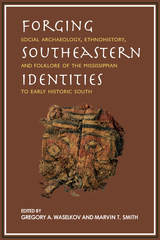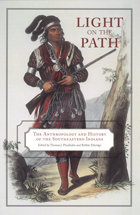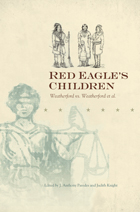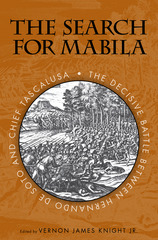4 books by Ethridge, Robbie

Forging Southeastern Identities
Social Archaeology, Ethnohistory, and Folklore of the Mississippian to Early Historic South
Gregory A. Waselkov
University of Alabama Press, 2017
Forging Southeastern Identities: Social Archaeology and Ethnohistory of the Mississippian to Early Historic South, a groundbreaking collection of ten essays, covers a broad expanse of time—from the ninth to the nineteenth centuries—and focuses on a common theme of identity. These essays represent the various methods used by esteemed scholars today to study how Native Americans in the distant past created new social identities when old ideas of the self were challenged by changes in circumstance or by historical contingencies.
Archaeologists, anthropologists, and folklorists working in the Southeast have always recognized the region’s social diversity; indeed, the central purpose of these disciplines is to study peoples overlooked by the mainstream. Yet the ability to define and trace the origins of a collective social identity—the means by which individuals or groups align themselves, always in contrast to others—has proven to be an elusive goal. Here, editors Gregory A. Waselkov and Marvin T. Smith champion the relational identification and categorical identification processes, taken from sociological theory, as effective analytical tools.
Taking up the challenge, the contributors have deployed an eclectic range of approaches to establish and inform an overarching theme of identity. Some investigate shell gorgets, textiles, shell trade, infrastructure, specific sites, or plant usage. Others focus on the edges of the Mississippian world or examine colonial encounters between Europeans and native peoples. A final chapter considers the adaptive malleability of historical legend in the telling and hearing of slave narratives.
Archaeologists, anthropologists, and folklorists working in the Southeast have always recognized the region’s social diversity; indeed, the central purpose of these disciplines is to study peoples overlooked by the mainstream. Yet the ability to define and trace the origins of a collective social identity—the means by which individuals or groups align themselves, always in contrast to others—has proven to be an elusive goal. Here, editors Gregory A. Waselkov and Marvin T. Smith champion the relational identification and categorical identification processes, taken from sociological theory, as effective analytical tools.
Taking up the challenge, the contributors have deployed an eclectic range of approaches to establish and inform an overarching theme of identity. Some investigate shell gorgets, textiles, shell trade, infrastructure, specific sites, or plant usage. Others focus on the edges of the Mississippian world or examine colonial encounters between Europeans and native peoples. A final chapter considers the adaptive malleability of historical legend in the telling and hearing of slave narratives.
[more]

Light on the Path
The Anthropology and History of the Southeastern Indians
Thomas J. Pluckhahn
University of Alabama Press, 2006
A seamless social history of the native peoples of the American South, bridging prehistory and history.
The past 20 years have witnessed a change in the study of the prehistory and history of the native peoples of the American South. This paradigm shift is the bridging of prehistory and history to fashion a seamless social history that includes not only the 16th-century Late Mississippian period and the 18th-century colonial period but also the largely forgotten--and critically important--century in between. The shift is in part methodological, for it involves combining methods from anthropology, history, and archaeology. It is also conceptual and theoretical, employing historical and archaeological data to reconstruct broad patterns of history--not just political history with Native Americans as a backdrop, nor simply an archaeology with added historical specificity, but a true social history of the Southeastern Indians, spanning their entire existence in the American South.
The scholarship underlying this shift comes from many directions, but much of the groundwork can be attributed to Charles Hudson. The papers in this volume were contributed by Hudson’s colleagues and former students (many now leading scholars themselves) in his honor. The assumption links these papers is that of a historical transformation between Mississippian societies and the Indian societies of the historic era that requires explanation and critical analysis.
In all of the chapters, the legacy of Hudson’s work is evident. Anthropologists, archaeologists, and historians are storming the bridge that connects prehistory and history in a manner unimaginable 20 years ago. While there remains much work to do on the path toward understanding this transformation and constructing a complete social history of the Southeastern Indians, the work of Charles Hudson and his colleagues have shown the way.
[more]

Red Eagle's Children
Weatherford vs. Weatherford et al.
Edited by J. Anthony Paredes and Judith Knight
University of Alabama Press, 2012
Red Eagle’s Children presents the legal proceedings in an inheritance dispute that serves as an unexpected window on the intersection of two cultural and legal systems: Creek Indian and Euro-American.
Case 1299: Weatherford vs. Weatherford et al. appeared in the Chancery Court of Mobile in 1846 when William “Red Eagle” Weatherford’s son by the Indian woman Supalamy sued his half siblings fathered by Weatherford with two other Creek women, Polly Moniac and Mary Stiggins, for a greater share of Weatherford’s estate. While the court recognized William Jr. as the son of William Sr., he nevertheless lost his petition for inheritance due to the lack of legal evidence concerning the marriage of his biological mother to William Sr. The case, which went to the Alabama Supreme Court in 1851, provides a record of an attempt to interrelate and, perhaps, manipulate differences in cultures as they played out within the ritualized, arcane world of antebellum Alabama jurisprudence.
Although the case has value in the classic mold of salvage ethnography of Creek Indian culture, Red Eagle’s Children, edited by J. Anthony Paredes and Judith Knight, shows that its more enduring value lies in being a source for historical ethnography—that is, for anthropological analyses of cultural dynamics of the past
events that complement the narratives of professional historians.
events that complement the narratives of professional historians.
Contributors
David I. Durham / Robbie Ethridge / Judith
Knight / J. Anthony Paredes / Paul M. Pruitt
Jr. / Nina Gail Thrower / Robert Thrower /
Gregory A. Waselkov
David I. Durham / Robbie Ethridge / Judith
Knight / J. Anthony Paredes / Paul M. Pruitt
Jr. / Nina Gail Thrower / Robert Thrower /
Gregory A. Waselkov
[more]

The Search for Mabila
The Decisive Battle between Hernando de Soto and Chief Tascalusa
Edited by Vernon James Knight Jr.
University of Alabama Press, 2009
One of the most profound events in sixteenth-century North America was a ferocious battle between the Spanish army of Hernando de Soto and a larger force of Indian warriors under the leadership of a feared chieftain named Tascalusa. The site of this battle was a small fortified border town within an Indian province known as Mabila. Although the Indians were defeated, the battle was a decisive blow to Spanish plans for the conquest and settlement of what is now the southeastern United States. For in that battle, De Soto’s army lost its baggage, including all proofs of the richness of the land—proofs that would be necessary to attract future colonists. Facing such a severe setback, De Soto led his army once more into the interior of the continent, where he was not to survive. The ragtag remnants of his once-mighty expedition limped into Mexico some three years later, thankful to be alive. The clear message of their ordeal was that this new land, then known as La Florida, could not be easily subjugated.
But where, exactly, did this decisive battle of Mabila take place? The accounts left by the Spanish chroniclers provide clues, but they are vague, so lacking in corroboration that without additional supporting evidence, it is impossible to trace De Soto’s trail on a modern map with any degree of certainty. Within this volume, 17 scholars—specialists in history, folklore, geography, geology, and archaeology—provide a new and encouragingly fresh perspective on the current status of the search for Mabila. Although there is a widespread consensus that the event took place in the southern part of what is now Alabama, the truth is that to this day, nobody knows where Mabila is—neither the contributors to this volume, nor any of the historians and archaeologists, amateur and professional, who have long sought it. One can rightfully say that the lost battle site of Mabila is the predominant historical mystery of the Deep South.
[more]
READERS
Browse our collection.
PUBLISHERS
See BiblioVault's publisher services.
STUDENT SERVICES
Files for college accessibility offices.
UChicago Accessibility Resources
home | accessibility | search | about | contact us
BiblioVault ® 2001 - 2024
The University of Chicago Press









